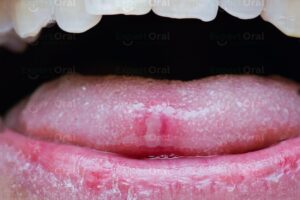A sudden, unwelcome visitor on your tongue or inner cheek – the dreaded canker sore. These small, shallow ulcers can be quite bothersome, causing pain and discomfort while eating, talking, and even smiling. But what exactly causes these pesky sores, and how can you manage them effectively? Let’s delve into the world of canker sores and explore ways to find relief.
Cause of canker sores:
Unfortunately, the exact cause of canker sores remains a bit of a mystery. However, several factors are believed to contribute to their development:
- Minor injuries: Accidental bites to the cheek or tongue while eating, brushing too vigorously, or ill-fitting dentures can trigger canker sores.
- Stress: Emotional stress and anxiety can be potential triggers for some individuals.
- Dietary factors: Certain foods like acidic fruits (citrus), spicy foods, and chocolate might aggravate canker sores in some people.
- Nutritional deficiencies: Deficiencies in vitamin B12, iron, or folic acid might be linked to canker sores.
- Hormonal fluctuations: Changes in hormone levels during menstruation can increase susceptibility to canker sores in some women.
- Weakened immune system: A weakened immune system due to illness or a medical condition might make you more prone to canker sores.
- Certain medications: Some medications, like nonsteroidal anti-inflammatory drugs (NSAIDs) like ibuprofen, might contribute to canker sores in some cases.
Foods that cause canker sores
Certain foods are known to be potential triggers or irritants for some individuals. Here’s a breakdown of foods commonly associated with canker sores:
Acidic Foods:
- Citrus fruits: Grapefruits, oranges, lemons, limes, pineapples
- Tomatoes: Tomatoes and tomato-based products like ketchup and salsa
- Other acidic fruits: Tart apples, kiwi fruit
Spicy Foods:
- Chili peppers, hot sauce, curries, and other dishes with strong spices
Other Potential Triggers:
-
- Chocolate: Cocoa can be an irritant for some people.
- Coffee: While the caffeine itself might not be the culprit, the acidity in coffee can trigger canker sores in some.
- Nuts and seeds: Almonds, peanuts, cashews, and sunflower seeds might irritate canker sores due to their texture.
- Processed foods: Foods high in sodium, artificial flavors, and preservatives might contribute to canker sores in some individuals.
Are canker sores contagious?
It’s important to note that canker sores are not contagious. You cannot catch them from someone else or spread them through kissing or sharing utensils.
Unlike cold sores (fever blisters) caused by the herpes simplex virus, canker sores are not transmissible. You cannot catch them from someone else or spread them through kissing, sharing utensils, or close contact.
Here’s a helpful analogy: Think of canker sores as internal injuries within your mouth, while cold sores are like external blisters caused by a virus.

Recognizing the Signs and Symptoms:
Canker sores are typically:
- Small, round, or oval-shaped ulcers with a white or grayish center surrounded by a red border.
- Located on the inside of your lips, cheeks, tongue, or the soft palate at the roof of your mouth.
- Tender to the touch and can cause pain or burning discomfort, especially when eating, drinking, or brushing your teeth.
Common site of canker sores
The most common sites for canker sores are on the soft tissues inside the mouth that are not keratinized. Keratin is a tough protein that forms the outermost layer of the skin and also helps protect some tissues inside the mouth.
Here’s a breakdown of the most frequent locations for canker sores:
- Inner cheeks: This is the most common location for canker sores.
- Tongue (especially the underside): The underside of the tongue is another frequent spot for canker sores.
- Inner lip: The inner lining of the lips can also be affected by canker sores.
- Soft palate: The soft palate is the fleshy area at the roof of the mouth near the back. Less commonly, canker sores can develop here.

Locations Where Canker Sores Don’t Typically Occur:
- Gums: Canker sores typically don’t appear on the gums, which are covered in a tougher, keratinized tissue.
- Teeth: Canker sores won’t develop on the teeth themselves, as teeth are made of enamel and dentin, not soft tissue.
- Outer lips: Unlike cold sores (fever blisters) caused by a virus, canker sores don’t appear on the outer lips.
Soothing the Discomfort:
While there’s no cure for canker sores, several strategies can help manage their discomfort and promote healing:
- Over-the-counter pain relievers: Medications like acetaminophen or ibuprofen can help alleviate pain and inflammation.
- Topical ointments: Over-the-counter topical ointments or gels containing lidocaine or benzocaine can numb the area and provide temporary pain relief.
- Rinsing with a saltwater solution: Mix half a teaspoon of table salt in a cup of warm water and rinse your mouth several times a day. This can help reduce inflammation and discomfort.
- Maintain good oral hygiene: Brushing your teeth gently twice a day and flossing regularly helps remove food particles and bacteria that can irritate the sores. Use a soft-bristled toothbrush to minimize further irritation.
- Dietary modifications: If you suspect certain foods trigger your canker sores, consider avoiding them for a while. Keep a food diary to identify potential triggers.
- Stress management: Techniques like meditation or yoga can help manage stress, which might be a contributing factor for some individuals.
When to Seek Professional Help:
While most canker sores typically heal within one to two weeks, it’s crucial to consult a dentist or doctor if you experience:
- Large or severe canker sores
- Canker sores that last longer than three weeks
- Frequent outbreaks of canker sores (more than three or four times a year)
- Difficulty eating or drinking due to pain
- Fever along with canker sores
Living with Canker Sores:
Canker sores may be a recurring nuisance, but understanding the potential causes and implementing effective management strategies can minimize their impact. If you have any concerns about canker sores or suspect underlying issues, don’t hesitate to consult your dentist or doctor for personalized guidance.
Additional Resources:
- American Academy of Oral and Maxillofacial Pathology (AAOMP) on Canker Sores: https://aaomp.org/
- National Institute of Dental and Craniofacial Research on Canker Sores
Disclaimer: The information provided in this blog is for general informational purposes only and should not be construed as medical advice. Please consult with a qualified dentist or physician for personalized recommendations and treatment options regarding canker sores.



